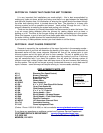
Note: You will notice the flame die down; however, this does not mean the fire has
gone out. This unit is designed to burn wood more efficiently and slower-burning wood
does not generate much flame.
9. Once you are sure the combustor is operating properly, the slide damper on the front
of the stove can be adjusted to the desired burn rate.
Note: It is important the above procedures be followed to ensure the catalytic
combustor reaches the proper temperature. It is recommended the combustor be
operated at 770 to 1400 degrees Fahrenheit; the combustor must be above 500 degrees
Fahrenheit before it will accept the smoke. Operating the combustor above 1800
degrees will damage the combustor, although temperatures between 1400 and 1600
degrees are common. If minor build-up is evident on the combustor, run the stove at a
high rate for two to three hours with the by-pass damper partially open. This will help the
combustor clean itself of minor contamination. (Call 800-516-3636 to order Part # AC-14
– Catalytic Thermometer for fireplace inserts.)
B. Draft Control
The unit has a slide damper located above the door that allows combustion air to
enter the stove, and controls the amount of air and the total heat output of the unit. In the
right position the damper is completely closed, and sliding it to the left allows air to enter
the firebox. You will need to experiment with your stove to find the best position for your
combustion air, as no two flues are alike. The long burn cycle can usually be
accomplished with an opening of one-half to one inch (1/2” to 1”). Remember that all flue
systems draw differently.
C. Do Not Over-Fire Your Stove
Burning flammable liquids, large amounts of wood or trash in your stove may result in
over-firing the unit. If the chimney connector pipe turns red or white, the unit is over-fired;
this condition may ignite creosote in the chimney and possibly cause a house fire. If this
happens, immediately close the combustion air draft control and the by-pass damper. A
chimney fire may cause structural damage to the flue system, which should not be used
again until it is thoroughly inspected. A chimney sweep can perform this inspection and
make repairs if necessary.
D. Everyday Fueling
This unit is designed to burn eight to ten hours on one filling of seasoned wood. At
the end of the long burn cycle you should follow the listed procedure for the next long
burn cycle.
1. Always open (pull out) the by-pass damper before opening the front door of the
stove. Then, open the combustion air damper by sliding it completely to the left.
2. Crack the door about one inch (1”) for three to five minutes. This will allow the draft
to increase and clear the smoke that is in the stove.
3. Open the door slowly and you should see a bed of hot ashes. Smooth out the ashes
and fill the unit with dry seasoned wood (split wood burns considerably better than
logs). Please refer to
Building A Fire (earlier in the manual) if your fire has gone out.













